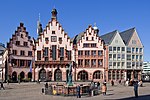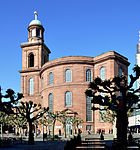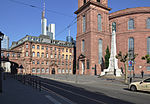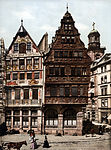St. Leonhard, Frankfurt
13th-century Roman Catholic church buildings in GermanyChurches completed in 1219Gothic architecture in GermanyRoman Catholic churches in FrankfurtRoman Catholic diocese of Limburg

St. Leonhard is a parish of the Roman Catholic Church in Frankfurt, Hesse, Germany. Its historic church dates to 1219, when it was erected in the centre of the town close to the river Main, as a Romanesque-style basilica. From 1425, it was remodeled to a hall church in late Gothic style. St. Leonhard was the only one of nine churches in the Old Town that survived World War II almost undamaged. Today, the parish is part of the Domgemeinde (Cathedral parish) and serves as the parish church of English-speaking Catholics. It is a monument of Frankfurt's history as well as church history and medieval crafts.
Excerpt from the Wikipedia article St. Leonhard, Frankfurt (License: CC BY-SA 3.0, Authors, Images).St. Leonhard, Frankfurt
Leonhardskirchhof, Frankfurt Altstadt (Innenstadt 1)
Geographical coordinates (GPS) Address External links Nearby Places Show on map
Geographical coordinates (GPS)
| Latitude | Longitude |
|---|---|
| N 50.1089 ° | E 8.6802 ° |
Address
Leonhardskirche
Leonhardskirchhof
60311 Frankfurt, Altstadt (Innenstadt 1, Innenstadt)
Hesse, Germany
Open on Google Maps










